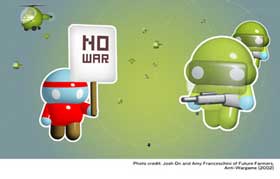I found on the always precious media teletipos and La Petite Claudine links to GAME as CRITIC as ART 2.0, a workshop to be held on January 12 in Barcelone. The documents written by Laura Baigorri from Barcelona University, as an introduction to the event are definitely worth a look. As they are spanish and i’m a good girl, i’ve made a summary of her texts for my dear readers. I’m doing this very quickly, so please bear with my usual typos! Whenever Laura Baigorri referred to a game, i didn’t translate her whole explanation of it, but added a couple of links to online texts that comment on the game in english.

The appropriation and deconstruction of the software of any videogame – reverse engineering – is a subversive act that implies a double intention: critical (revision) and creative (regeneration). In computer games written by artists, games, critics and creation combine to generate surprising and parodical products which invite further exploration.
The main public for these games is neither teenagers nor kids, but adults. Moreover, the rules of these games are not the ones you would encounter in a commercial games: the aim is not to attract as many game addicts during as much time as possible; to captivate with an aesthetics as realist as possible or with the most original design; to attain as much identification to the hero as possible; to be the most competitive on the market; to satisfy the ego of the teenager that still lurks in each of us by killing what moves on the screen… the aim is not to win. The aim is to subvert and parody preconceived ethics and aesthetics; to generate reflection.
Traditionally, most videogames evolve around fantastic situation that have nothing to do with our everyday reality. Over the past few years, however, the tendency of the game industry is to base its products on real situations: stereotypes of real characters evolving in real places. One of the main features of the games made by artists and activists is the systematical reference to real situations, because of their social and educational potential. The themes refer to current problems: migration, racial discrimination, identity, social injustice, corporations, sexual education, biased visions of history, war but also, here and there, critics of the institutional system of the art market. From here, we’ll analyse several projects that exemplify the three main strategies adopted by creators: converting the reward into a defeat, establishing new systems of social justice and using simulated violence to condemn real violence.
When the reward turns into a defeat
– Beaner, by Fran Ilich: players have to travel from Tijuana to San Diego. Using only the arrows of the keyboard, they must cross a river, then the desert to reach “elfriguey”. The reward? The same as any migrant without paper: wearisome and badly paid clandestine work.

– Antiwar Game (2001), by Josh On, explores the politics of the war on terror via a game simulation. In Antiwargame you take actions such as setting your budget, sending troops overseas and manipulating the media, with the goal of maintaining a popularity high enough to remain president. (via GTA)
– the very frustrating experience offered by GenderFactory, part of the GenderGame series and created by Marion Strunk and Deanna Herat.

– Natalie Bookchin’s Metapet. Metapet is the result of implanting a dog’s obedience gene into a developing human. The Metapet was created to be a productive and diligent worker. The user/player oversees the job performance of the metapet and soon finds that this technological creation may be more problematic than it is productive.
The real perversion of these works is their ability to emulate real life, to underline the mechanisms of our social system and to express in a merciless way our inadequacy or frustration when we are confronted to those situations. The message of those games seems to be: “You cannot escape a dystopian reality.”
From dystopia to utopia. New systems of social justice
Games with “constructive-educative” characteristics. Their objective is to propose new systems of social justice.
– Andreja Kuluncic‘s Distributive Justice. Conceived as a work in progress that questions the current distribution model. 2 parts: an exhibition space with screenings, presentations, debates and workshops and an online game. Players have to fill in questionnaires to determine the type of society they prefer, distributing material and immaterial goods according to the options they have selected.(see also Neural)
– The online community AgoraXchange (2004), by Natalie Bookchin and Jacqueline Stevens. (See the Tate page on the game)
